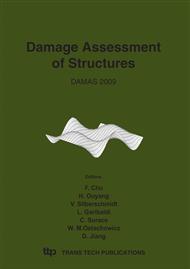p.87
p.95
p.101
p.109
p.117
p.125
p.135
p.143
p.151
Identification of Crack Parameters in a Cantilever Beam under Uncertain End Conditions
Abstract:
The local effect of “softening” at the crack location can be simulated by an equivalent spring connecting the two segments of the beam. As modelling the crack, the non-perfectly rigid clamp is also simulated as a torsional spring of unknown stiffness. Combined with the Bernoulli-Euler theories of beam, the present model is applied to derive the characteristic equation of the cantilever beam under uncertain end conditions related to the crack parameters, namely, the location and the depth of the crack. Based on this characteristic equation, an accurate crack identification method is developed to identify the location and the depth of the crack by minimizing the difference between the analytical and experimental frequency values. The proposed approach is verified by two cantilever beam experiments under ideal boundary conditions and uncertain end conditions. It is found that the location and the depth of the crack can be worked out when at least three natural frequencies are known. For crack identification of the cantilever beam under uncertain end conditions, the identified crack location of the proposed approach is more accurate than the Narkis’ method. Furthermore, the crack depth can also be obtained by the present method.
Info:
Periodical:
Pages:
117-124
Citation:
Online since:
June 2009
Authors:
Keywords:
Price:
Сopyright:
© 2009 Trans Tech Publications Ltd. All Rights Reserved
Share:
Citation:


